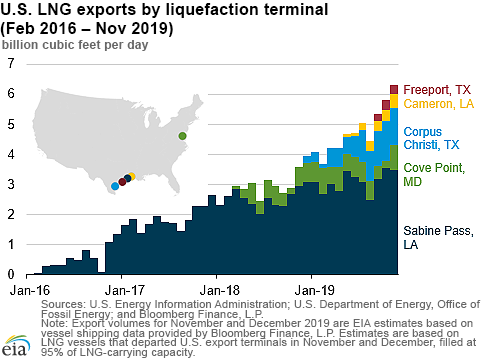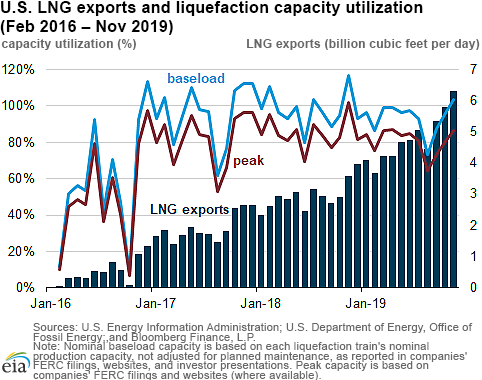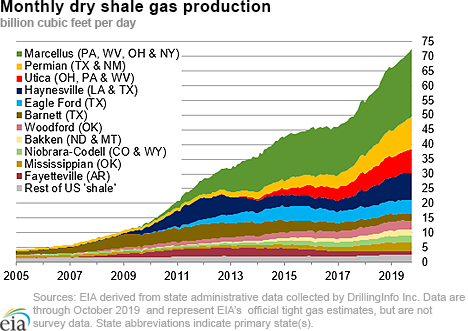In the News:
Vessel loadings show record levels of U.S. LNG exports in October and November
U.S. exports of liquefied natural gas (LNG) set two consecutive records in October and November 2019. LNG exports averaged 5.8 billion cubic feet per day (Bcf/d) with 52 exported cargoes in October and 6.3 Bcf/d with 55 exported cargoes in November, according to EIA estimates based on the shipping data provided by Bloomberg Finance, L.P. From January through November 2019, U.S. LNG exports averaged 4.8 Bcf/d, 61% higher than in 2018 (3.0 Bcf/d annual average), as the United States became the third-largest LNG exporter in the world.
Growing liquefaction capacity has supported growth in LNG exports. Two new facilities—Cameron LNG and Freeport LNG—placed their first liquefaction units (referred to as trains) in service this year, in May and September, respectively. Corpus Christi LNG commissioned its second train in July. Elba Island started LNG production from the first five of its Moveable Modular Liquefaction System (MMLS) units and is currently loading first export cargo. EIA estimates U.S. LNG nominal liquefaction capacity in operation to be 6.1 Bcf/d baseload (7.5 Bcf/d peak) across six facilities and 15 trains (10 standard-size liquefaction trains and 5 small modular liquefaction units).
Natural gas feedstock deliveries to U.S. LNG export facilities have been the fastest growing consumption sector for U.S. natural gas in 2019, increasing by 2.8 Bcf/d between January and November, based on pipeline flow data provided by IHS Markit. Feedstock deliveries exceeded 6 Bcf/d for the first time in July, averaged 7.4 Bcf/d in November, and exceeded 8.3 Bcf/d in the second week of December as Freeport LNG started LNG production from its second train. EIA expects feedstock deliveries to continue to increase as the remaining trains at Freeport, Cameron, and Elba Island are placed in service in 2020, followed by the third train at Corpus Christi in 2021.
From January through November 2019, EIA estimates that capacity utilization of U.S. liquefaction facilities averaged 93% baseload, or 81% peak. Sabine Pass and Corpus Christi had the highest utilization of production capacity among U.S. LNG export facilities, at 105% and 91% baseload capacity, respectively, over the 11-month period. Cheniere Energy, the operator of Sabine Pass and Corpus Christi LNG terminals, filed applications with the Federal Energy Regulatory Commission (FERC) requesting authorization to increase operational capacity of Sabine Pass and Corpus Christi based on technical upgrades that have optimized the operational performance of the facilities. Cameron LNG ramped up baseload production capacity to 77% in November, and Freeport LNG, since commissioning Train 1 in September, ramped up production to 50% in October and November. Because commissioning new liquefaction trains is done gradually over time, utilization of the facilities in the first several months of operations typically remains below 50%.
The latest information on the status of U.S. liquefaction facilities, including expected online dates and capacities, is available in EIA's database of U.S. LNG export facilities.
Overview:
(For the week ending Wednesday, December 11, 2019)
- Natural gas spot price movements were mixed this report week (Wednesday, December 4 to Wednesday, December 11). The Henry Hub spot price fell from $2.37 per million British thermal units (MMBtu) last Wednesday to $2.26/MMBtu yesterday.
- At the New York Mercantile Exchange (Nymex), the price of the January 2020 contract decreased 16¢, from $2.399/MMBtu last Wednesday to $2.243/MMBtu yesterday. The price of the 12-month strip averaging January 2020 through December 2020 futures contracts declined 6¢/MMBtu to $2.274/MMBtu.
- The net withdrawal from working gas totaled 73 billion cubic feet (Bcf) for the week ending December 6. Working natural gas stocks total 3,518 Bcf, which is 20% more than the year-ago level and the same as the five-year (2014–18) average for this week.
- The natural gas plant liquids composite price at Mont Belvieu, Texas, fell by 17¢/MMBtu, averaging $5.60/MMBtu for the week ending December 11. The prices of ethane, propane, isobutane, and butane fell by 7%, 5%, 5%, and 2%, respectively. The price of natural gasoline rose by 3%.
- According to Baker Hughes, for the week ending Tuesday, December 3, the natural gas rig count increased by 2 rigs to 133. The number of oil-directed rigs decreased by 5 rigs to 663. The total rig count decreased by 3 rigs, and it now stands at 799.
Prices/Supply/Demand:
Prices at major hubs decline with mild temperatures. This report week (Wednesday, December 4 to Wednesday, December 11), the Henry Hub spot price fell 11¢ from a high of $2.37/MMBtu last Wednesday to $2.26/MMBtu yesterday. Temperatures across the Lower 48 states were generally warmer than normal, with colder temperatures across the Great Plains. At the Chicago Citygate, the price decreased 6¢ from a high of $2.19/MMBtu last Wednesday to $2.13/MMBtu yesterday.
California prices are mixed. The price at PG&E Citygate in Northern California fell 7¢, down from $3.28/MMBtu last Wednesday to a low of $3.21/MMBtu yesterday. The price at SoCal Citygate in Southern California increased 3¢ from $5.12/MMBtu last Wednesday to $5.15/MMBtu yesterday.
Northeast prices rise with the onset of colder temperatures. At the Algonquin Citygate, which serves Boston-area consumers, the price went up 70¢ from $3.78/MMBtu last Wednesday to $4.48/MMBtu yesterday. At the Transcontinental Pipeline Zone 6 trading point for New York City, the price increased 48¢ from $2.36/MMBtu last Wednesday to $2.84/MMBtu yesterday. Although temperatures were at or above normal throughout the report week, both Boston and New York City experienced colder-than-normal temperatures yesterday and today (Thursday, December 12).
The Tennessee Zone 4 Marcellus spot price was constant week over week at $1.79/MMBtu. The price at Dominion South in southwest Pennsylvania rose 3¢ from $1.80/MMBtu last Wednesday to $1.83/MMBtu yesterday.
Permian Basin price discount to the Henry Hub narrows. The price at the Waha Hub in West Texas, which is located near Permian Basin production activities, averaged $1.49/MMBtu last Wednesday, 88¢/MMBtu lower than the Henry Hub price. Yesterday, the price at the Waha Hub averaged $1.50/MMBtu, 76¢/MMBtu lower than the Henry Hub price.
Supply is flat. According to data from IHS Markit, the average total supply of natural gas remained the same as in the previous report week, averaging 100.4 Bcf/d. Dry natural gas production remained constant week over week. Average net imports from Canada increased by 5% from last week.
Demand rises, driven by electric power sector. Total U.S. consumption of natural gas rose by 2% compared with the previous report week, according to data from IHS Markit. Natural gas consumed for power generation climbed by 6% week over week. Industrial sector consumption decreased by 3% week over week. In the residential and commercial sectors, consumption increased by 2%. Natural gas exports to Mexico increased 2% as Fermaca’s 1.3 Bcf/d La Laguna-Aguascalientes (LL-AGC) natural gas pipeline (the central leg of the Wahalajara system connecting natural gas from the Permian Basin to Mexican demand markets) started commercial operations. According to Genscape, however, the pipeline is not expected to flow significant volumes of natural gas until the lower leg of the system—the Villa de Reyes-Aguascalientes-Guadalajara pipeline—enters service in 2020.
U.S. LNG exports increase week over week. Fourteen LNG vessels (seven from Sabine Pass; two each from Corpus Christi, Cameron, and Freeport; and one from Cove Point) with a combined LNG-carrying capacity of 51 Bcf departed the United States between December 5 and December 11, according to shipping data compiled by Bloomberg. Two vessels (one at Sabine Pass and one at Cove Point) were loading on Wednesday.
Elba Island LNG, after commissioning the first 5 of its 10 small liquefaction trains, called Moveable Modular Liquefaction System (MMLS), is reportedly loading its first export cargo.
Storage:
The net withdrawal from storage totaled 73 Bcf for the week ending December 6, compared with the five-year (2014–18) average net withdrawal of 68 Bcf and last year's net withdrawal of 75 Bcf during the same week. Working natural gas stocks totaled 3,518 Bcf, which is 14 Bcf lower than the five-year average and 593 Bcf more than last year at this time.
According to The Desk survey of natural gas analysts, estimates of the weekly net change to working natural gas stocks ranged from a net withdrawal of 66 Bcf to 82 Bcf, with a median estimate of 77 Bcf.
More storage data and analysis can be found on the Natural Gas Storage Dashboard and the Weekly Natural Gas Storage Report.
See also:
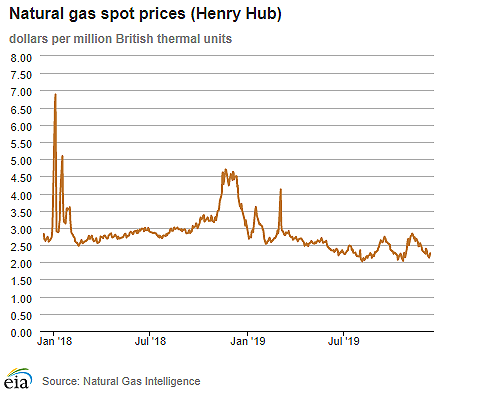
| Spot Prices ($/MMBtu) | Thu, 05-Dec |
Fri, 06-Dec |
Mon, 09-Dec |
Tue, 10-Dec |
Wed, 11-Dec |
|---|---|---|---|---|---|
| Henry Hub |
2.32 |
2.22 |
2.14 |
2.18 |
2.26 |
| New York |
2.41 |
2.18 |
2.16 |
3.30 |
2.84 |
| Chicago |
2.19 |
2.16 |
2.13 |
2.12 |
2.13 |
| Cal. Comp. Avg.* |
2.90 |
2.91 |
2.87 |
2.90 |
2.83 |
| Futures ($/MMBtu) | |||||
| January contract | 2.427 |
2.334 |
2.232 |
2.264 |
2.243 |
| February contract |
2.398 |
2.319 |
2.234 |
2.263 |
2.243 |
| *Avg. of NGI's reported prices for: Malin, PG&E Citygate, and Southern California Border Avg. | |||||
| Source: NGI's Daily Gas Price Index | |||||
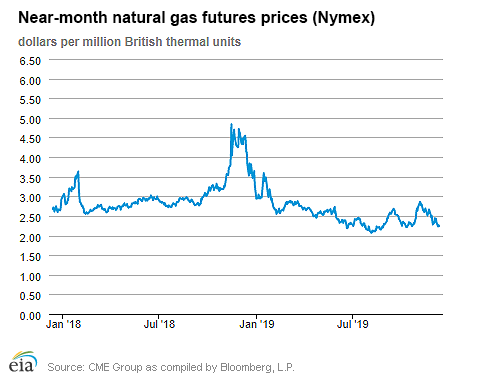
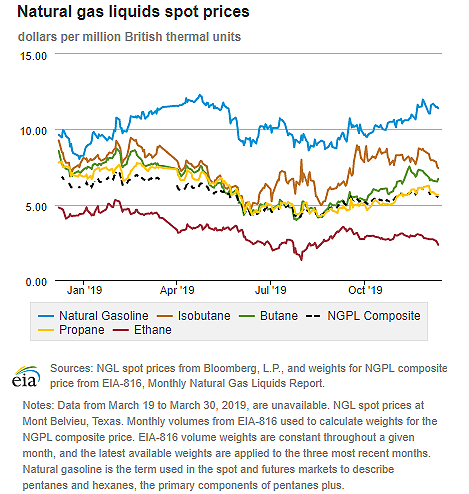
| U.S. natural gas supply - Gas Week: (12/5/19 - 12/11/19) | |||
|---|---|---|---|
Average daily values (Bcf/d): |
|||
this week |
last week |
last year |
|
| Marketed production | 109.4 |
109.8 |
99.2 |
| Dry production | 96.3 |
96.7 |
88.1 |
| Net Canada imports | 3.9 |
3.7 |
4.9 |
| LNG pipeline deliveries | 0.2 |
0.2 |
0.2 |
| Total supply | 100.4 |
100.6 |
93.1 |
|
Source: IHS Markit | |||
| U.S. natural gas consumption - Gas Week: (12/5/19 - 12/11/19) | |||
|---|---|---|---|
Average daily values (Bcf/d): |
|||
this week |
last week |
last year |
|
| U.S. consumption | 91.3 |
89.6 |
98.9 |
| Power | 28.4 |
26.7 |
28.6 |
| Industrial | 23.6 |
24.4 |
24.0 |
| Residential/commercial | 39.4 |
38.5 |
46.3 |
| Mexico exports | 5.3 |
5.2 |
4.7 |
| Pipeline fuel use/losses | 7.3 |
7.3 |
7.1 |
| LNG pipeline receipts | 7.9 |
7.5 |
4.6 |
| Total demand | 111.8 |
109.5 |
115.3 |
|
Source: IHS Markit | |||
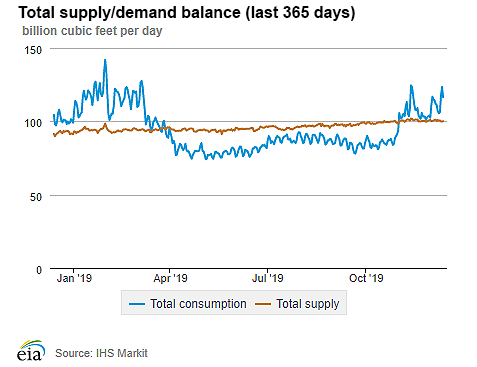
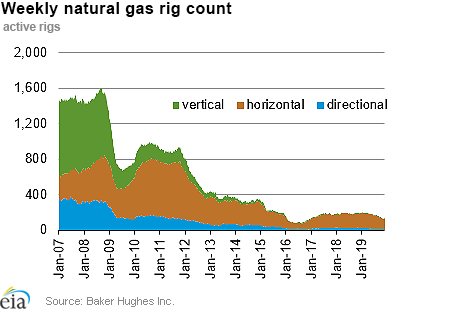
| Rigs | |||
|---|---|---|---|
Tue, December 03, 2019 |
Change from |
||
last week |
last year |
||
| Oil rigs | 663 |
-0.7% |
-24.4% |
| Natural gas rigs | 133 |
1.5% |
-32.8% |
| Note: Excludes any miscellaneous rigs | |||
| Rig numbers by type | |||
|---|---|---|---|
Tue, December 03, 2019 |
Change from |
||
last week |
last year |
||
| Vertical | 52 |
8.3% |
-25.7% |
| Horizontal | 695 |
-0.9% |
-25.5% |
| Directional | 52 |
-1.9% |
-27.8% |
| Source: Baker Hughes Inc. | |||
| Working gas in underground storage | ||||
|---|---|---|---|---|
Stocks billion cubic feet (Bcf) |
||||
| Region | 2019-12-06 |
2019-11-29 |
change |
|
| East | 867 |
891 |
-24 |
|
| Midwest | 1,013 |
1,040 |
-27 |
|
| Mountain | 193 |
200 |
-7 |
|
| Pacific | 276 |
286 |
-10 |
|
| South Central | 1,168 |
1,174 |
-6 |
|
| Total | 3,518 |
3,591 |
-73 |
|
|
Source: Form EIA-912, Weekly Underground Natural Gas Storage Report | ||||
| Working gas in underground storage | |||||
|---|---|---|---|---|---|
Historical comparisons |
|||||
Year ago (12/6/18) |
5-year average (2014-2018) |
||||
| Region | Stocks (Bcf) |
% change |
Stocks (Bcf) |
% change |
|
| East | 735 |
18.0 |
839 |
3.3 |
|
| Midwest | 889 |
13.9 |
1,009 |
0.4 |
|
| Mountain | 161 |
19.9 |
200 |
-3.5 |
|
| Pacific | 240 |
15.0 |
312 |
-11.5 |
|
| South Central | 899 |
29.9 |
1,173 |
-0.4 |
|
| Total | 2,925 |
20.3 |
3,532 |
-0.4 |
|
| Source: Form EIA-912, Weekly Underground Natural Gas Storage Report | |||||
| Temperature – heating & cooling degree days (week ending Dec 05) | ||||||||
|---|---|---|---|---|---|---|---|---|
HDD deviation from: |
CDD deviation from: |
|||||||
| Region | HDD Current |
normal |
last year |
CDD Current |
normal |
last year |
||
| New England | 240 |
36 |
41 |
0 |
0 |
0 |
||
| Middle Atlantic | 219 |
25 |
28 |
0 |
0 |
0 |
||
| E N Central | 205 |
-18 |
-7 |
0 |
0 |
0 |
||
| W N Central | 216 |
-33 |
-23 |
0 |
0 |
0 |
||
| South Atlantic | 131 |
-4 |
3 |
6 |
-4 |
-6 |
||
| E S Central | 129 |
-10 |
11 |
0 |
-1 |
-1 |
||
| W S Central | 73 |
-28 |
-8 |
7 |
4 |
-2 |
||
| Mountain | 204 |
-5 |
-11 |
0 |
0 |
0 |
||
| Pacific | 125 |
16 |
5 |
0 |
-1 |
0 |
||
| United States | 171 |
-3 |
2 |
2 |
0 |
-1 |
||
|
Note: HDD = heating degree day; CDD = cooling degree day Source: National Oceanic and Atmospheric Administration | ||||||||
Average temperature (°F)
7-day mean ending Dec 05, 2019
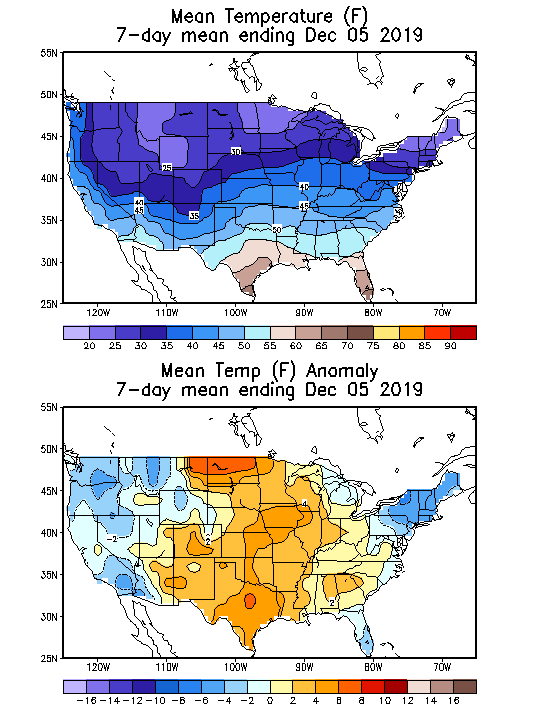
Source: National Oceanic and Atmospheric Administration
Deviation between average and normal (°F)
7-day mean ending Dec 05, 2019

Source: National Oceanic and Atmospheric Administration

